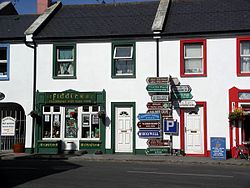Ballyvaughan
|
Ballyvaughan Baile Uí Bheacháin
|
|
|---|---|
| Village | |

The junction at the centre of Ballyvaughan, still featuring the full signpost.
|
|
| Location in Ireland | |
| Coordinates: 53°06′56″N 9°08′58″W / 53.115556°N 9.1494004°WCoordinates: 53°06′56″N 9°08′58″W / 53.115556°N 9.1494004°W | |
| Country | Ireland |
| Province | Munster |
| County | County Clare |
| Elevation | 5 m (16 ft) |
| Population (2011) | |
| • Urban | 258 |
| Time zone | WET (UTC+0) |
| • Summer (DST) | IST (WEST) (UTC-1) |
| Irish Grid Reference | M264077 |
| Website | www |
Ballyvaughan or Ballyvaghan (Irish: Baile Uí Bheacháin, meaning "Ó Beachán's townland") is a small harbour village in County Clare, Ireland. It is located on the N67 road on the south shores of Galway Bay, in the northwest corner of The Burren. This position on the coast road and the close proximity to many of the area's sights has turned the village into a local center of tourism activity. At the time of the 2011 Census Ballyvaughan had a population of 258. The area was officially classified as part of the West Clare Gaeltacht, an Irish-speaking community, until 1956.
The site was originally occupied by Ballyvaughan Castle, which stood right at the edge of the harbour. It was owned and occupied by the O'Loghlen family, except for a period in the 16th century when the O'Brians held it. In 1540, a stolen cow was found at the castle, and heavy fines were levied on the O'Loghlens—loss of cattle, goats, sheep and the town of Ballyvaughan. In 1569 the castle was attacked by Sir Henry Sidney but the O'Loghlens held on to the property. By 1840, the castle was in ruins. Only the foundations remain today.
On the promontory on which the castle was situated (and on which the Irish Cottage scheme is today located) there were also other late medieval dwellings. According to Westropp's survey of Clare antiquities, the area contained "three small forts and a much levelled ring of a great Caher".
The present village grew around the harbour in the 19th century, when it temporarily was a thriving port. Three older piers had been built by the villagers, who used them for herring fishing. However, these piers were almost unusable at high tide and in 1829 the Fishery Board had a new quay constructed. This was designed by Alexander Nimmo. By 1831, turf from Connemara was landed here in great quantities, despite the shallowness of the bay. At that point, the town had 23 houses and 151 inhabitants. In 1837, to facilitate the turf trade, another quay was constructed, apparently also based on a design of Nimmo's. By 1841 the village had grown to 235 inhabitants and 35 houses. The new quay was of great importance, as it allowed Ballyvaughan to export grain, bacon and vegetables and to import supplies from Galway. For a while, Ballyvaughan was the official capital of this region of Clare, sporting its own workhouse, coastguard station and a large police barracks. Over time, as the roads improved and the piers fell into disrepair, the town lost its importance as a fishing harbour.
...
Wikipedia

